Derby's Heritage Part 29 - Old Friends
w/e 27 May 2012
All this week's pictures were taken
with a Kodak DX6490
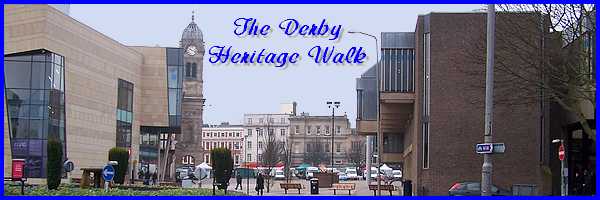
This part of the walk around Derby is a little like
meeting old friends as we return to St Peter's Street and end
near Albert Street passing some familiar figures and an animal
statue on the way.
  We resume at The Spot which was redesigned
in the early 1990s when a clock by Smiths of Derby was installed
as part of the Derby Promenade pedestrianisation scheme. The
name "The Spot" appears to have its origins in premises
on the corner of London Road and Osmaston Road belonging to maltster
Abraham Ward. Originally named "The Spot in Derby"
in 1741, it had changed to "on the Spot" a year later
and subsequently the name became associated with the whole area. We resume at The Spot which was redesigned
in the early 1990s when a clock by Smiths of Derby was installed
as part of the Derby Promenade pedestrianisation scheme. The
name "The Spot" appears to have its origins in premises
on the corner of London Road and Osmaston Road belonging to maltster
Abraham Ward. Originally named "The Spot in Derby"
in 1741, it had changed to "on the Spot" a year later
and subsequently the name became associated with the whole area.

On the Osmaston Road side of The Spot there is a building with
pretensions of the Tudor period but it was actually built about
1890 and was occupied by the drapery store of E. W. Grimes between
1897 and 1956. Today the building is split between two businesses.
|
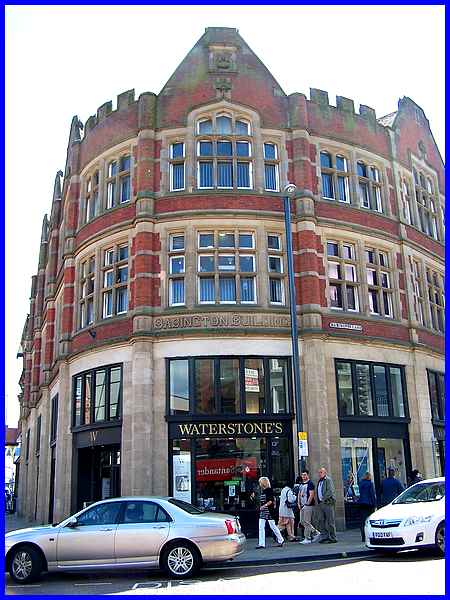
The third street to meet London Road and Osmaston Road at The
Spot is the first of our "old friends". This is St
Peter's Street part of which we explored earlier in the walk
but now we are approaching from the opposite direction. On the
corner of St Peter's Street and Babington Lane are the Babington
Buildings. Dating from 1898 as a Boot and Shoe Emporium they
were designed by John Wills for Councillor G. E. Franklin and
are now home to a branch of a national book shop. They were named
after the large Jacobean house that stood nearby until 1897.
It was in the original Babington House that Mary Queen of Scots
stayed overnight on her way to Tutbury where she was imprisoned
at Castle at the behest of Queen Elizabeth I.
|
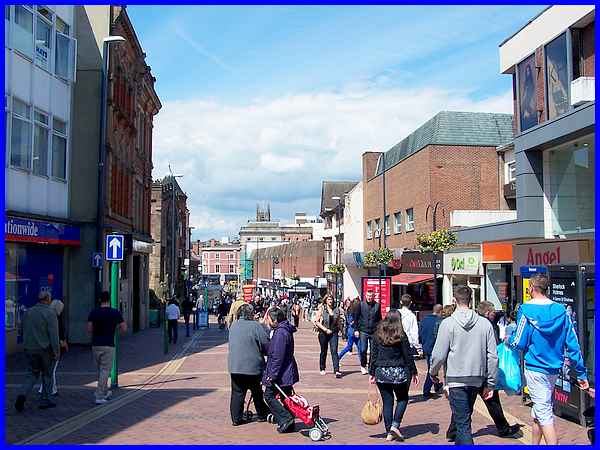
From its junction with Babington Lane, this is the view down
St Peter's Street to the Corn Market and Derby Cathedral in the
distance with St Peter's Church on the left.
|
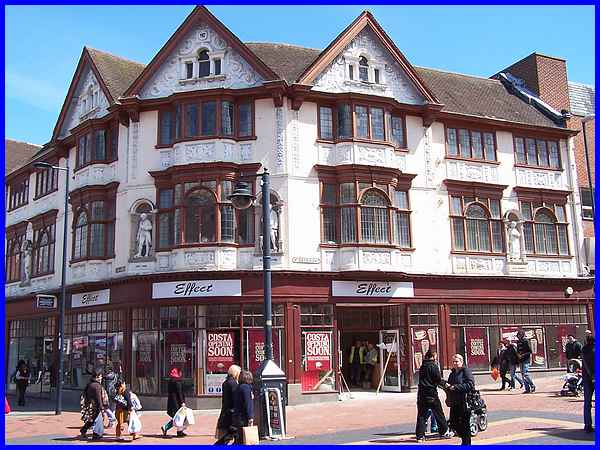
Across from the church and on the corner of East Street is the
former Boots Building. This was built at the beginning of the
twentieth century for the Nottingham based chemists and Boots
traded from here until the 1970s when they moved into the Eagle
Shopping Centre which has now been extended to become part of
the Westfield Centre. It is a listed Grade II building built
in the Arts and Crafts style by Albert Bromley of Nottingham
and is notable for four famous people associated with Derby incorporated
into its design.
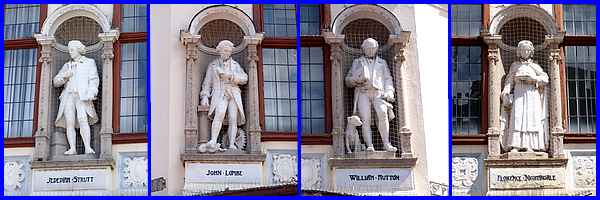
The statues by Morley Horder were created from plaster using
a method called pargetting which is an East Anglian craft. The
statues are from left to right, cotton mill owner Jedidiah Strutt;
co-founder of the Derby Silk Mill, John Lombe; poet and historian
William Hutton who counted among his works the first published
"History of Derby" (1791) and of course pioneering
nurse Florence Nightingale.
|

On the opposite corner of East Street, the modern architecture
does nothing at all to complement the former Boots Building but
a picture on the Picture The Past site from the 1940s showing
the former Midland
Drapery store shows the former glory and magnificence of
the area. East Street itself is an ancient route and is at least
eight hundred years old. It was formerly known as Bag Lane and
was recorded as such in 1220 when it was known as Baggelon from
the Middle English "bagge" meaning "beggar"
and "lanu" meaning "lane". Thought to be
the source of the 1635 plague because of the squalor in the area
it was widened in 1883 and again in 1898 being renamed about
the same time as East Street, taking its name rather unimaginatively
from the direction it ran from St Peter's Church.
|
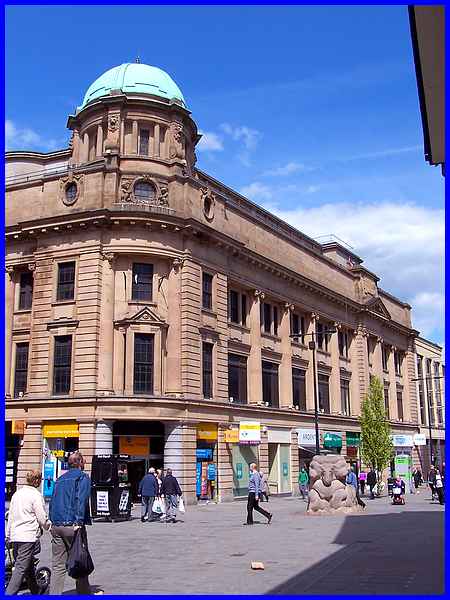
 About two-thirds
of the way down East Street it is crossed by Exchange Street
to the left and Albion Street to the right which leads into the
Westfield Centre and the Eagle Market. The architecture here
is much more classical in style than the brick and glass that
replaced the Midland Drapery store and the Co-Operative building
with the copper dome was designed by Alexander Macpherson with
building work beginning in 1912. It was not completed until 1917
with the stone detailing being carved by the Co-op's own stone
masons from their Funeral Service Department. Although no longer
occupied by the company, the Co-op still trades from its other
building from 1928 on the opposite corner of Exchange Street
(left). About two-thirds
of the way down East Street it is crossed by Exchange Street
to the left and Albion Street to the right which leads into the
Westfield Centre and the Eagle Market. The architecture here
is much more classical in style than the brick and glass that
replaced the Midland Drapery store and the Co-Operative building
with the copper dome was designed by Alexander Macpherson with
building work beginning in 1912. It was not completed until 1917
with the stone detailing being carved by the Co-op's own stone
masons from their Funeral Service Department. Although no longer
occupied by the company, the Co-op still trades from its other
building from 1928 on the opposite corner of Exchange Street
(left).
|

In the middle of the junction of East Street with Exchange Street
and Albion Street is the eight foot high statue that has occupied
this spot since 1995 of the Derby Ram sculptured in Derbyshire
gritstone by Michael Pegler. The soft drinks can is an optional
extra but the statue, a gift to Derby by the developers of the
Eagle Centre was unveiled by the then Mayor, Councillor John
McGiven. The Ram has long been associated with Derby and Derbyshire
and the 95th Derbyshire Regiment of Foot acquired a ram as a
mascot in India in 1838. Since then it has become the mascot
of the Sherwood Foresters and by association, the Mercian Regiment
as well as being the emblem of many other organisations in the
county, prominent among them of course being Derby County Football
Club. It is thought that the origins of the ram in folklore date
back to the pre-Christian animal gods and the tale of a giant
beast are recorded in the comic folk song "The Derby Ram".
(See
this page from 2002 for more about the Derby Ram).
|

Exchange Street linking Albert Street to East Street was created
in the mid 1870s taking its name from the Corn Exchange that
had been built on Albert Street in 1862. Like the Co-op building,
the Exchange Buildings too has a copper dome and the buildings
are now Grade II listed. They also have an interesting history
as they became the Palace Theatre of Varieties in 1897 with "twice
nightly" dancing but the dance hall was closed at the onset
of the First World War. Re-opening as the Palais de Danse in
1919 it then underwent another name change in 1929 when the local
newspaper, the Derby Evening Telegraph moved in to convert it
for office use as Northcliffe House. The newspaper continued
to use the Exchange Buildings until 1981 when they were sub-divided
to create several smaller units.
|

